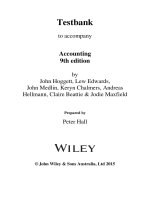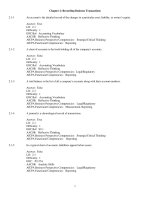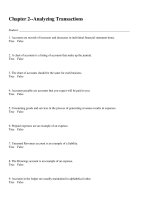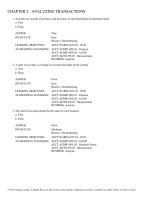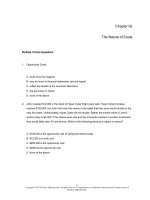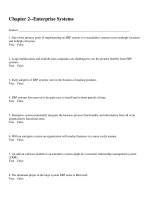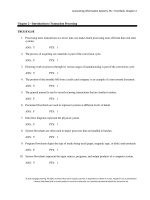Financial accounting 9th edition libby test bank
Bạn đang xem bản rút gọn của tài liệu. Xem và tải ngay bản đầy đủ của tài liệu tại đây (673.42 KB, 153 trang )
Chapter 02
Investing and Financing Decisions and the Accounting System
True / False Questions
1.
The primary objective of financial reporting is to provide useful information to external decision
makers.
True
2.
False
In order for information to be relevant, the information needs to be complete, neutral, and free from
error.
True
3.
False
In order for information to be relevant, the information should have both predictive and/or feedback
value.
True
4.
The continuity assumption states that a business will continue to operate into the foreseeable future.
True
5.
False
False
The current assets section of a balance sheet includes both inventory and prepaid expenses.
True
False
2-1
Copyright © 2017 McGraw-Hill Education. All rights reserved. No reproduction or distribution without the prior written consent of McGraw-Hill
Education.
6.
The stockholders' equity section of a balance sheet includes capital contributed by owners and also
retained earnings.
True
7.
False
Under the monetary unit assumption, accounting information should be measured and reported in
terms of the national monetary unit, with an adjustment for changes in purchasing power.
True
8.
Assets are reported on the balance sheet in the order of liquidity.
True
9.
False
False
Many valuable intangible assets such as trademarks and copyrights are not reported on a company's
balance sheet.
True
False
10. Stockholders' equity reflects the financing provided by owners.
True
False
11. Common stock and additional-paid in capital represent the financing sources from shareholders.
True
False
12. Financial reporting focuses on reporting the impact of transactions on an entity's financial position.
True
False
13. Unearned revenue is reported on the balance sheet as a liability and represents amounts paid to an
entity in exchange for future services and/or goods.
True
False
2-2
Copyright © 2017 McGraw-Hill Education. All rights reserved. No reproduction or distribution without the prior written consent of McGraw-Hill
Education.
14. A transaction may be an exchange of assets or services by one business for assets, services, or
promises to pay from a different business.
True
False
15. The dual effects concept implies that every transaction has at least two effects on the accounting
equation.
True
False
16. The accounting equation does not have to be in balance after the recording of each transaction.
True
False
17. Additional-paid in capital is reported on the balance sheet as a component of shareholders' equity.
True
False
18. Common stock and additional-paid in capital are both reported on the balance sheet as components
of shareholders' equity.
True
False
19. A company's assets and stockholders' equity both increase when the company sells additional shares
of stock in exchange for cash.
True
False
20. Purchasing supplies for cash results in an increase in total assets for the purchasing company.
True
False
21. The normal balance for an asset account is a debit and the normal balance for a liability account is a
credit.
True
False
2-3
Copyright © 2017 McGraw-Hill Education. All rights reserved. No reproduction or distribution without the prior written consent of McGraw-Hill
Education.
22. The recording of a journal entry precedes the posting to the general ledger.
True
False
23. An asset account normally has a debit balance and is increased by debiting the account.
True
False
24. Liability and stockholders' equity accounts normally have credit balances and are decreased by
debiting the accounts.
True
False
25. A journal entry is a written expression of the effects of a transaction on accounts and has equal debits
and credits.
True
False
26. The T-account is an actual account in the general ledger of the accounting records.
True
False
27. The T-account is very useful for accumulating the effects of transactions on account balances and for
determining individual account balances.
True
False
28. The trial balance is similar to the balance sheet in that it is a listing of assets, liabilities, and
stockholders' equity and is provided to external decision makers.
True
False
29. The trial balance is a listing of account balances that are found in the general ledger.
True
False
2-4
Copyright © 2017 McGraw-Hill Education. All rights reserved. No reproduction or distribution without the prior written consent of McGraw-Hill
Education.
30. An objective of preparing the trial balance is to test the equality of debits and credits.
True
False
31. Current assets include accounts receivable and prepaid expenses.
True
False
32. The current ratio is current assets divided by current liabilities.
True
False
33. Current liabilities are defined as obligations to be paid within six months.
True
False
34. The current ratio measures the ability of a company to pay its short-term obligations with short-term
assets.
True
False
35. A company with a high current ratio should never have liquidity problems.
True
False
36. When a company borrows money from a bank, the statement of cash flows will report a cash
increase from an investing activity.
True
False
37. Issuing stock in exchange for cash creates an increase in cash from a financing activity.
True
False
2-5
Copyright © 2017 McGraw-Hill Education. All rights reserved. No reproduction or distribution without the prior written consent of McGraw-Hill
Education.
Multiple Choice Questions
38. Which of the following statements about stockholders' equity is false?
A. Stockholders' equity is the shareholders' residual interest in the company resulting from the
difference in assets and liabilities.
B. Stockholders' equity accounts are increased with credits.
C. Stockholders' equity results only from contributions of the owners.
D. The purchase of land for cash has no effect on stockholders' equity.
39. Assets, liabilities, and stockholders' equity are all found within which of the following financial
statements?
A. Balance sheet.
B. Income statement.
C. The investing activities section of the Statement of Cash Flows.
D. Statement of stockholders' equity.
40. An accounts payable would be reported within which of the following financial statements?
A. Statement of cash flows.
B. Income statement.
C. Balance sheet.
D. Statement of stockholders' equity.
2-6
Copyright © 2017 McGraw-Hill Education. All rights reserved. No reproduction or distribution without the prior written consent of McGraw-Hill
Education.
41. Which of the following assumptions implies that a business can continue to remain in operation into
the foreseeable future?
A. Historical cost principle.
B. Monetary unit assumption.
C. Continuity assumption.
D. Separate-entity assumption.
42. Which of the following best describes assets?
A. Resources with possible future economic benefits owed by an entity as a result of past
transactions.
B. Resources with probable future economic benefits owned by an entity as a result of past
transactions.
C. Resources with probable future economic benefits owned by an entity as a result of future
transactions.
D. Resources with possible future economic benefits owed by an entity as a result of future
transactions.
43. Which of the following assumptions implies that the assets and liabilities of the business are
accounted for separately from the assets and liabilities of the owners?
A. Monetary unit assumption.
B. Continuity assumption.
C. Historical cost principle.
D. Separate entity assumption.
2-7
Copyright © 2017 McGraw-Hill Education. All rights reserved. No reproduction or distribution without the prior written consent of McGraw-Hill
Education.
44. Which of the following is a constraint in providing useful financial reporting information to decisionmakers?
A. Comparability
B. Timeliness
C. Cost-benefit
D. Understandability
45. Which of the following best describes liabilities?
A. Possible debts or obligations of an entity as a result of future transactions, which will be paid with
assets or services.
B. Possible debts or obligations of an entity as a result of past transactions, which will be paid with
assets or services.
C. Probable debts or obligations of an entity as a result of future transactions, which will be paid with
assets or services.
D. Probable debts or obligations of an entity as a result of past transactions, which will be paid with
assets or services.
46. Which of the following is included within current assets on a classified balance sheet?
A. Land.
B. A truck.
C. Inventory.
D. Intangible assets.
2-8
Copyright © 2017 McGraw-Hill Education. All rights reserved. No reproduction or distribution without the prior written consent of McGraw-Hill
Education.
47. Chad Jones is the sole owner and manager of Jones Glass Repair Shop. Jones purchased a truck, to
be used in the business, for its market value of $35,000. Which of the following fundamentals
requires Jones to record the truck at the price paid to buy it?
A. Separate-entity assumption.
B. Revenue principle.
C. Monetary unit assumption.
D. Historical cost principle.
48. In what order are current assets listed on a balance sheet?
A. By dollar amount (largest first).
B. By date of acquisition (earliest first).
C. By liquidity.
D. By relevance to the operation of the business.
49. In what order would the following assets be listed on a balance sheet?
A. Cash, Short-term Investments, Accounts Receivable, Inventory.
B. Cash, Intangible Assets, Accounts Receivable, Property and Equipment.
C. Cash, Accounts Receivable, Property and Equipment, Inventory.
D. Cash, Inventory, Intangible Assets, Accounts Receivable.
50. Where would changes in stockholders' equity resulting from financing provided by operations be
reported?
A. Within a long-term asset account.
B. Within the additional paid-in capital account.
C. Within a liability account.
D. Within the retained earnings account.
2-9
Copyright © 2017 McGraw-Hill Education. All rights reserved. No reproduction or distribution without the prior written consent of McGraw-Hill
Education.
51. Which of the following events will cause retained earnings to increase?
A. Dividends declared by the Board of Directors.
B. Net income reported for the period.
C. Net loss reported for the period.
D. Issuance of stock in exchange for cash.
52. Which of the following correctly describes retained earnings?
A. It is the cumulative earnings of a company.
B. It represents the investments by stockholders in a company.
C. It equals total assets minus total liabilities.
D. It is the cumulative earnings of a company less dividends declared.
53. Which of the following statements is false?
A. The benefits of providing financial reporting information should outweigh the costs.
B. An item is considered relevant if it has the ability to influence a decision.
C. Information is considered to be faithfully represented when it is complete, neutral, and free from
error.
D. Accounting information should be reported in the national monetary unit with adjustment for
inflation.
54. Which of the following describes the primary objective of financial accounting?
A. To provide useful financial information only to stockholders.
B. To provide information about a business' future business strategies.
C. To provide useful financial information about a business to help external parties make informed
decisions.
D. To provide useful financial information about a business to help internal parties make informed
decisions.
2-10
Copyright © 2017 McGraw-Hill Education. All rights reserved. No reproduction or distribution without the prior written consent of McGraw-Hill
Education.
55. For accounting information to be useful, it must be which of the following?
A. It must be consistent and comparable.
B. It must be a faithful representation and relevant.
C. It must be comparable and reliable.
D. It must be relevant and consistent.
56. Which of the following would not be considered a current asset?
A. Inventory.
B. Prepaid expenses.
C. Land used in daily operations.
D. Accounts receivable.
57. Which of the following statements is true?
A. Contributed capital is a noncurrent asset.
B. Current liabilities are debts expected to be paid within the next year.
C. Current assets are resources of a company that might include cash and copyrights.
D. Patents, copyrights, and research and development expense are classified as intangible assets on
the balance sheet.
58. Which of the following does not correctly describe business transactions or events?
A. They include exchanges of assets or services by one business for assets, services, or promises to
pay from another business.
B. They include the using up of insurance paid for in advance.
C. They have an economic impact on a business entity.
D. They do not include measurable internal events such as the use of assets in operations.
2-11
Copyright © 2017 McGraw-Hill Education. All rights reserved. No reproduction or distribution without the prior written consent of McGraw-Hill
Education.
59. Which of the following would not be included under the account category of expenses within the chart
of accounts?
A. Cost of goods sold.
B. Interest expense.
C. Prepaid insurance expense.
D. Income tax expense.
60. Which of the following liability accounts does not usually require a future cash payment?
A. Accounts payable.
B. Unearned revenues.
C. Taxes payable.
D. Notes payable.
61. Which of the following transactions would not be considered an external exchange?
A. The purchase of supplies on credit.
B. Cash received from the issuance of common stock.
C. Cash paid to a bank for interest on a loan.
D. Using up insurance, which had been paid for in advance.
62. Which of the following reflects the impact of a transaction where $200,000 cash was invested by
stockholders in exchange for stock?
A. Assets and retained earnings each increased $200,000.
B. Assets and revenues each increased $200,000.
C. Stockholders' equity and revenues each increased $200,000.
D. Stockholders' equity and assets each increased $200,000.
2-12
Copyright © 2017 McGraw-Hill Education. All rights reserved. No reproduction or distribution without the prior written consent of McGraw-Hill
Education.
63. A corporation purchased factory equipment using cash. Which of the following statements regarding
this purchase is correct?
A. The cost of the factory equipment is an expense at the time of purchase.
B. The total assets will not change.
C. The total liabilities will increase.
D. The current stockholders' equity will decrease.
64. Which of the following direct effects on the accounting equation is not possible as a result of a single
business transaction which impacts only two accounts?
A. An increase in a liability and a decrease in an asset.
B. An increase in stockholders' equity and an increase in an asset.
C. An increase in an asset and a decrease in an asset.
D. A decrease in stockholders' equity and a decrease in an asset.
65. Which of the following direct effects on the accounting equation is not possible as a result of a single
business transaction which impacts only two accounts?
A. An increase in an asset and a decrease in another asset.
B. An increase in an asset and an increase in stockholders' equity.
C. A decrease in stockholders' equity and an increase in an asset.
D. An increase in a liability and an increase in an asset.
2-13
Copyright © 2017 McGraw-Hill Education. All rights reserved. No reproduction or distribution without the prior written consent of McGraw-Hill
Education.
66. A company's January 1, 2016 balance sheet reported total assets of $150,000 and total liabilities of
$60,000. During January 2016, the company completed the following transactions: (A) paid a note
payable using $10,000 cash (no interest was paid); (B) collected a $9,000 accounts receivable; (C)
paid a $5,000 accounts payable; and (D) purchased a truck for $5,000 cash and by signing a $20,000
note payable from a bank. The company's January 31, 2016 balance sheet would report which of the
following?
A.
B.
C.
D.
Assets
Liabilities
$150,000
$60,000
Assets
Liabilities
$155,000
$65,000
Assets
Liabilities
$160,000
$75,000
Assets
Liabilities
Stockholder's
Equity
$90,000
Stockholder's
Equity
$90,000
Stockholder's
Equity
$85,000
Stockholder's
$170,000 $100,000
Equity
$70,000
67. Which of the following is a result of equipment purchased with cash?
A. Total assets decrease.
B. Current assets do not change.
C. Current assets increase.
D. Stockholders' equity does not change.
2-14
Copyright © 2017 McGraw-Hill Education. All rights reserved. No reproduction or distribution without the prior written consent of McGraw-Hill
Education.
68. A company's January 1, 2016 balance sheet reported total assets of $120,000 and total liabilities of
$40,000. During January 2016, the following transactions occurred: (A) the company issued stock
and collected cash totaling $30,000; (B) the company paid an account payable of $6,000; (C) the
company purchased supplies for $1,000 with cash; (D) the company purchased land for $60,000
paying $10,000 with cash and signing a note payable for the balance. What is total stockholders'
equity after the transactions above?
A. $30,000.
B. $110,000.
C. $80,000.
D. $194,000.
69. Which of the following describes the impact on the balance sheet of purchasing supplies for cash?
A. Current assets will decrease.
B. Current assets will increase.
C. Stockholders' equity will decrease.
D. Total assets remain the same.
70. Which of the following describes the impact on the balance sheet of paying a current liability using
cash?
A. Current assets will decrease.
B. Current liabilities will increase.
C. Stockholders' equity will decrease.
D. Total assets will remain the same.
2-15
Copyright © 2017 McGraw-Hill Education. All rights reserved. No reproduction or distribution without the prior written consent of McGraw-Hill
Education.
71. Which of the following describes the impact on the balance sheet when cash is received from the
collection of an account receivable?
A. Current assets will not change.
B. Current assets will increase.
C. Stockholders' equity will increase.
D. Total assets will increase.
72. A corporation has $80,000 in total assets, $36,000 in total liabilities, and a $12,000 credit balance in
retained earnings. What is the balance in the contributed capital accounts?
A. $56,000.
B. $44,000.
C. $48,000.
D. $32,000.
73. The dual effects concept states that:
A. Both the income statement and balance sheet are impacted by every transaction.
B. Every transaction has an impact on assets and stockholders' equity.
C. There are only two accounts involved in every transaction.
D. Every transaction has at least two effects on the accounting equation.
74. Which of the following is not considered to be a recordable transaction?
A. Signing a contract to have an outside cleaning service clean offices nightly.
B. Paying employees their wages.
C. Selling stock to investors.
D. Buying equipment and agreeing to pay a note payable and interest at the end of a year.
2-16
Copyright © 2017 McGraw-Hill Education. All rights reserved. No reproduction or distribution without the prior written consent of McGraw-Hill
Education.
75. Which of the following transactions will cause both the left and right side of the accounting equation to
decrease?
A. Collecting cash from a customer who owed us money.
B. Paying a supplier for inventory we previously purchased on account.
C. Borrowing money from a bank.
D. Purchasing equipment using cash.
76. When a company buys equipment for $150,000 and pays for one third in cash and the other two
thirds is financed by a note payable, which of the following are the effects on the accounting
equation?
A. Total assets increase $150,000.
B. Total liabilities increase $150,000.
C. Total liabilities decrease $50,000.
D. Total assets increase $100,000.
77. Which of the following describes the impact on the balance sheet when a company uses cash to
purchase the stock of another company?
A. Total assets increase.
B. Stockholders' equity increases.
C. Stockholders' equity decreases.
D. Total assets remain the same.
78. Which of the following transactions will not change a company's total stockholders' equity?
A. Reporting of net income.
B. Issuing stock to stockholders in exchange for cash.
C. The declaration of a cash dividend.
D. The purchase of a factory building.
2-17
Copyright © 2017 McGraw-Hill Education. All rights reserved. No reproduction or distribution without the prior written consent of McGraw-Hill
Education.
79. Alpha Company issued 1,000 shares of $10 par value common stock to stockholders, in exchange for
$15,000 cash. Which of the following correctly describes the impact of this transaction on Alpha's
financial statements?
A. A $15,000 investment is reported as a long-term investment.
B. Stockholders have invested $25,000 as stockholders' equity.
C. Common stock is reported at $15,000 in stockholders' equity.
D. Additional paid-in capital of $5,000 is reported in stockholders' equity.
80. Which of the following statements is incorrect?
A. Stockholders' equity accounts normally have credit balances.
B. Liability accounts are decreased by credits.
C. Stockholders' equity accounts are increased by credits.
D. Asset accounts are increased by debits.
81. Selling stock to investors for cash would result in which of the following?
A. A debit to additional paid-in capital and a credit to cash.
B. A credit to both cash and additional paid-in capital.
C. A debit to cash and a credit to common stock.
D. A debit to cash and a credit to the investment account.
82. Borrowing cash from a bank would result in which of the following?
A. A debit to cash and a credit to notes payable.
B. A debit to notes payable and a credit to cash.
C. A debit to both cash and notes payable.
D. A debit to cash and a credit to additional paid-in capital.
2-18
Copyright © 2017 McGraw-Hill Education. All rights reserved. No reproduction or distribution without the prior written consent of McGraw-Hill
Education.
83. Which of the following journal entries is correct when common stock is sold for cash at a price greater
than par value?
A. Cash
xxx
Retained earnings
B. Cash
xxx
xxx
Additional paid-in capital
C. Cash
xxx
xxx
Common Stock
D. Cash
xxx
xxx
Common stock
xxx
Additional paid-in capital
xxx
84. Which of the following statements is false?
A. The common stock account has a credit balance.
B. The additional paid-in capital account has a credit balance.
C. Common stock may be issued for more than par value.
D. The par value of common stock represents the stock's market value.
85. A company purchases a delivery van by paying $5,000 cash and by signing a $25,000 note payable.
Which of the following correctly describes the recording of the delivery van purchase?
A. The delivery van account is debited for $25,000.
B. Notes payable is debited for $25,000.
C. The delivery van account is debited for $30,000.
D. Cash is debited for $5,000.
2-19
Copyright © 2017 McGraw-Hill Education. All rights reserved. No reproduction or distribution without the prior written consent of McGraw-Hill
Education.
86. Cadet Company paid an accounts payable of $1,000. This transaction should be recorded on the
payment date as follows:
A. Accounts payable
1,000
Cash
B. Cash
1,000
1,000
Accounts payable
C. Notes Payable
1,000
1,000
Cash
D. Cash
Cost of Goods Sold
1,000
1,000
1,000
87. Centex, Inc. issued 50,000 shares of its $1 par value common stock for $20 per share. The journal
entry to record the stock issue would include which of the following?
A. A credit to cash for $1,000,000.
B. A credit to additional paid-in capital for $1,000,000.
C. A credit to additional paid-in capital for $50,000.
D. A credit to common stock for $50,000.
88. Which of the following correctly describes the recording of a dividend declaration by a company's
board of directors?
A. A debit to retained earnings and a credit to cash.
B. A debit to additional paid-in capital and a credit to dividends payable.
C. A debit to cash and a credit to retained earnings.
D. A debit to retained earnings and a credit to dividends payable.
2-20
Copyright © 2017 McGraw-Hill Education. All rights reserved. No reproduction or distribution without the prior written consent of McGraw-Hill
Education.
89. Superior has provided the following information for its recent year of operation:
The common stock account balance at the beginning of the year was $20,000 and the year-end
balance was $25,000.
The additional paid-in capital account balance increased $2,500 during the year.
The retained earnings balance at the beginning of the year was $75,000 and the year-end balance
was $91,000.
Net income was $26,000.
How much were Superior's dividend declarations during its recent year of operation?
A. $10,000.
B. $42,000.
C. $26,000.
D. The dividend declarations cannot be determined from the information provided.
90. Superior has provided the following information for its recent year of operation:
The common stock account balance at the beginning of the year was $20,000 and the year-end
balance was $25,000.
The additional paid-in capital account balance increased $2,500 during the year.
The retained earnings balance at the beginning of the year was $75,000 and the year-end balance
was $91,000.
Net income was $26,000.
How much did Superior sell its common stock for during the year?
A. $5,000.
B. $2,500.
C. $7,500.
D. $27,500.
2-21
Copyright © 2017 McGraw-Hill Education. All rights reserved. No reproduction or distribution without the prior written consent of McGraw-Hill
Education.
91. Which of the following statements is correct?
A. Assets normally have a credit balance and are increased with debits.
B. Assets normally have a debit balance and are increased with credits.
C. Liability accounts normally have debit balances and are increased with debits.
D. Stockholders' equity accounts normally have credit balances and are increased with credits.
92. Which of the following journal entries is correct when a business entity purchases land costing
$30,000 by signing a one-year note payable?
A. Cash
30,000
Notes Payable
B. Land
30,000
30,000
Accounts payable
C. Land
30,000
30,000
Notes Payable
D. Notes Payable
Land
30,000
30,000
30,000
2-22
Copyright © 2017 McGraw-Hill Education. All rights reserved. No reproduction or distribution without the prior written consent of McGraw-Hill
Education.
93. Which of the following journal entries is correct when a business entity issues common stock, above
par value, to stockholders in exchange for cash?
A. Cash
xxx
Common stock
xxx
Retained earnings
xxx
B. Cash
xxx
Common stock
xxx
Additional paid-in capital
xxx
C. Cash
xxx
Investments
D. Common stock
Cash
xxx
xxx
xxx
2-23
Copyright © 2017 McGraw-Hill Education. All rights reserved. No reproduction or distribution without the prior written consent of McGraw-Hill
Education.
94. Which of the following journal entries is correct when a business entity purchases a building by
paying cash and by signing a note payable for the balance?
A. Building
xxx
Cash
xxx
Notes Payable
xxx
B. Building
xxx
Cash
C. Cash
xxx
xxx
Notes Payable
xxx
Building
xxx
D. Building
xxx
Cash
xxx
Notes Payable
xxx
2-24
Copyright © 2017 McGraw-Hill Education. All rights reserved. No reproduction or distribution without the prior written consent of McGraw-Hill
Education.
95.Which of the following journal entries is correct when a business entity pays cash for advertising to be
used next year?
A. Cash
xxx
Advertising expense
B. Advertising expense
xxx
xxx
Cash
C. Cash
xxx
xxx
Prepaid advertising expense
D. Prepaid advertising expense
xxx
xxx
Cash
xxx
96. Which of the following journal entries is correct when a business entity uses cash to pay an account
payable?
A. Accounts Payable
xxx
Cash
B. Accounts Receivable
xxx
xxx
Cash
C. Cash
xxx
xxx
Accounts Payable
D. Cash
Notes Payable
xxx
xxx
xxx
2-25
Copyright © 2017 McGraw-Hill Education. All rights reserved. No reproduction or distribution without the prior written consent of McGraw-Hill
Education.
